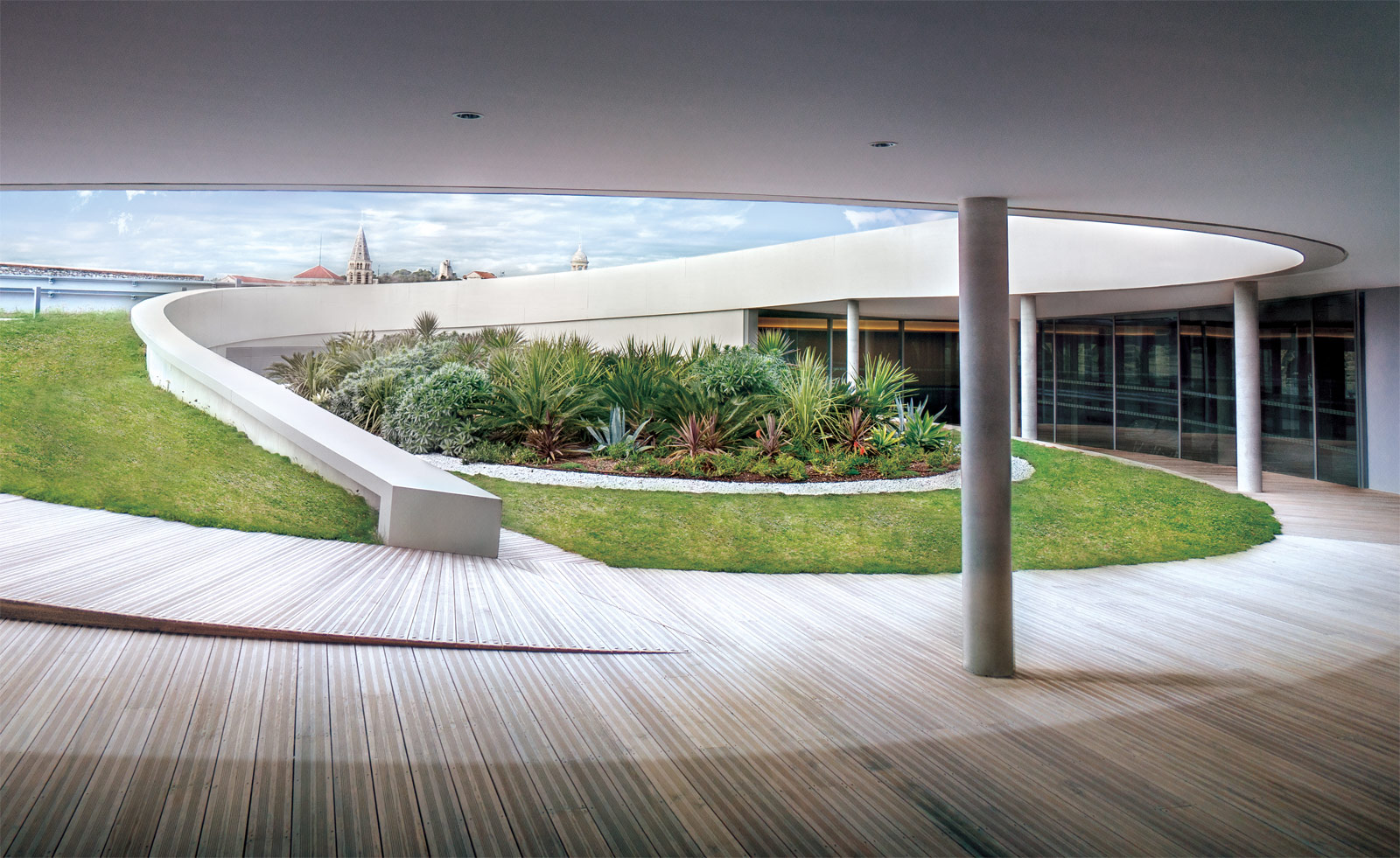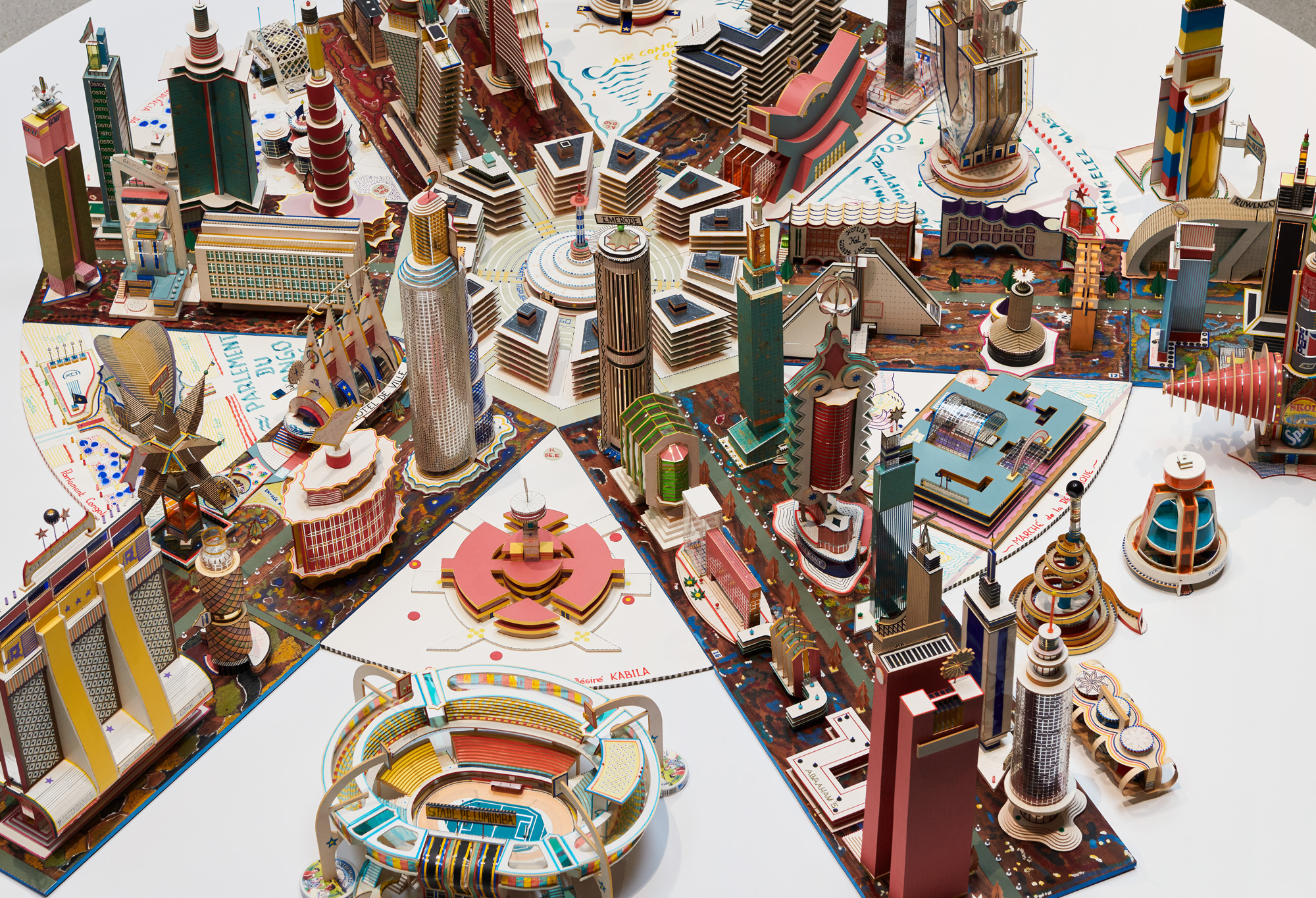Elizabeth de Portzamparc embeds a museum into the historic centre of Nîmes

In the French city of Nîmes, Elizabeth de Portzamparc’s Musée de la Romanité Museography is a contemporary building settled within a layered, historic city centre. Straddling the ruins of the Roman Amphitheatre, the building is a gateway through its ground floor museum arcade and soaring atrium, and a lens for the surrounding architecture with its roof terrace and glazed facades.
When architect de Portzamparc entered the competition for the design, which was awarded in 2012, her intention was for the museum to complement the existing architecture and urban fabric of the city, not to compete with it. The façade, made of a translucent skin of screen-printed glass plates, creates a reflective mosaic that balances the heavy stone amphitheatre opposite

Interior circulation through the museum.
The building takes the form of an urban promenade, defined by a series of openings and framed views. A public interior street based upon the route of an ancient Augustan rampart guides people through the museum, linking up to the amphitheatre plaza and an archaeological garden.
This pathway is entirely transparent so the public can explore the site visually and the collection on display on their way through. The 17m-high atrium frames a fragment of the propylaea of the Sanctuary of the Fountain within a reconstitution of the sacred site that dates to the foundation of the pre-Roman city.
RELATED STORY

Also along this route, visitors will find the bookstore, café and the restaurant, La table du 2, from chef Franck Putelat, who earned two Michelin stars for Le Parc in Carcassonne.
The galleries follow a similarly urban style plan, with squares and circulation spaces that connect like a series of streets, holding around 5,000 pieces dating from the 7th century B.C. to the 19th century.

The contemporary architecture meets the Roman amphitheatre.
The journey is completed with a green roof terrace, designed by de Portzamparc after her initial competition entry, to open up further views over Nîmes with the amphitheatre in the foreground and the Magne Tower, dating from the city’s founding, in the distance.
Back down at ground level, the 3,500 sq m archaeological garden imagined by Régis Guignard is designed around three periods of history – Gallic, Roman and medieval – to create a ‘green museum’ connecting to the Roman wall and other historical vestiges, further embedding the contemporary museum into its site.









Receive our daily digest of inspiration, escapism and design stories from around the world direct to your inbox.
Harriet Thorpe is a writer, journalist and editor covering architecture, design and culture, with particular interest in sustainability, 20th-century architecture and community. After studying History of Art at the School of Oriental and African Studies (SOAS) and Journalism at City University in London, she developed her interest in architecture working at Wallpaper* magazine and today contributes to Wallpaper*, The World of Interiors and Icon magazine, amongst other titles. She is author of The Sustainable City (2022, Hoxton Mini Press), a book about sustainable architecture in London, and the Modern Cambridge Map (2023, Blue Crow Media), a map of 20th-century architecture in Cambridge, the city where she grew up.
-
 Brunello Cucinelli’s festive takeover of Harrods turns the department store into a cashmere wonderland
Brunello Cucinelli’s festive takeover of Harrods turns the department store into a cashmere wonderlandUnveiled this morning, the Umbrian fashion house has taken over the store’s iconic Brompton Road windows, celebrating the spirit of its home town of Solomeo in fantastical fashion
-
 Each mundane object tells a story at Pace’s tribute to the everyday
Each mundane object tells a story at Pace’s tribute to the everydayIn a group exhibition, ‘Monument to the Unimportant’, artists give the seemingly insignificant – from discarded clothes to weeds in cracks – a longer look
-
 Discover The Legacy, Hong Kong’s eye-catching new condo
Discover The Legacy, Hong Kong’s eye-catching new condoThe Legacy, by ACPV Architects Antonio Citterio Patricia Viel, is a striking new condo tower that aims to ‘create a sense of community and solidarity among people’
-
 ‘You have to be courageous and experimental’: inside Fondation Cartier’s new home
‘You have to be courageous and experimental’: inside Fondation Cartier’s new homeFondation Cartier pour l'art contemporain in Paris invites us into its new home, a movable feast expertly designed by Jean Nouvel
-
 A wellness retreat in south-west France blends rural charm with contemporary concrete
A wellness retreat in south-west France blends rural charm with contemporary concreteBindloss Dawes has completed the Amassa Retreat in Gascony, restoring and upgrading an ancient barn with sensitive modern updates to create a serene yoga studio
-
 Explore the new Hermès workshop, a building designed for 'things that are not to be rushed'
Explore the new Hermès workshop, a building designed for 'things that are not to be rushed'In France, a new Hermès workshop for leather goods in the hamlet of L'Isle-d'Espagnac was conceived for taking things slow, flying the flag for the brand's craft-based approach
-
 ‘Landscape architecture is the queen of science’: Emanuele Coccia in conversation with Bas Smets
‘Landscape architecture is the queen of science’: Emanuele Coccia in conversation with Bas SmetsItalian philosopher Emanuele Coccia meets Belgian landscape architect Bas Smets to discuss nature, cities and ‘biospheric thinking’
-
 An apartment is for sale within Cité Radieuse, Le Corbusier’s iconic brutalist landmark
An apartment is for sale within Cité Radieuse, Le Corbusier’s iconic brutalist landmarkOnce a radical experiment in urban living, Cité Radieuse remains a beacon of brutalist architecture. Now, a coveted duplex within its walls has come on the market
-
 Maison Louis Carré, the only Alvar Aalto house in France, reopens after restoration
Maison Louis Carré, the only Alvar Aalto house in France, reopens after restorationDesigned by the modernist architect in the 1950s as the home of art dealer Louis Carré, the newly restored property is now open to visit again – take our tour
-
 Meet Ferdinand Fillod, a forgotten pioneer of prefabricated architecture
Meet Ferdinand Fillod, a forgotten pioneer of prefabricated architectureHis clever flat-pack structures were 'a little like Ikea before its time.'
-
 Eileen Gray: A guide to the pioneering modernist’s life and work
Eileen Gray: A guide to the pioneering modernist’s life and workGray forever shaped the course of design and architecture. Here's everything to know about her inspiring career